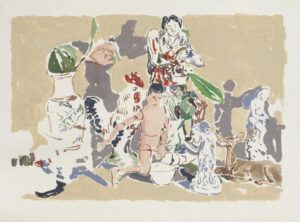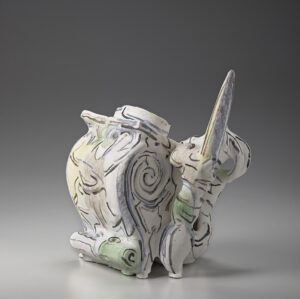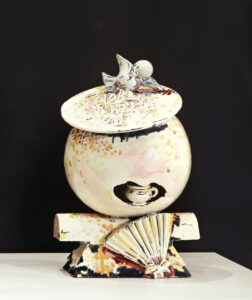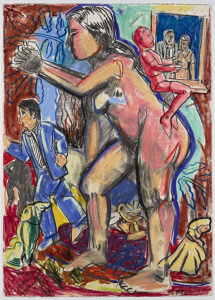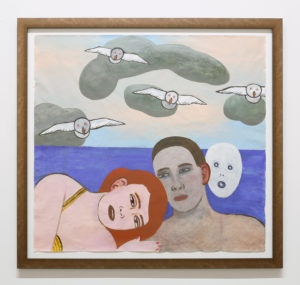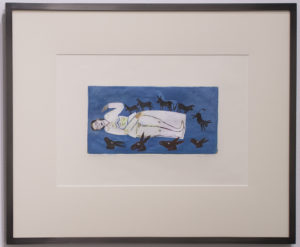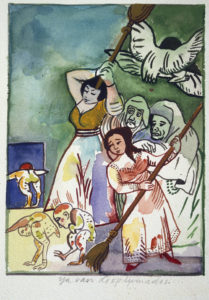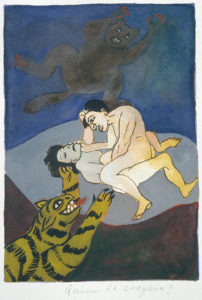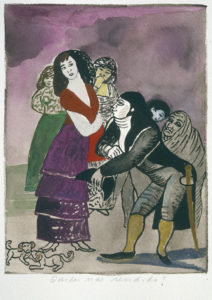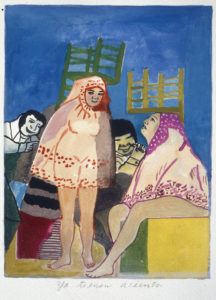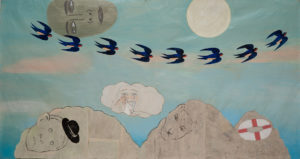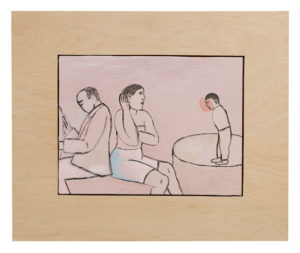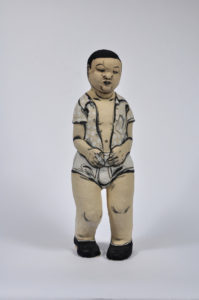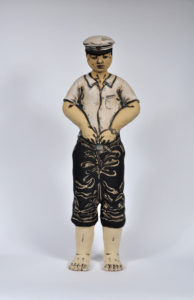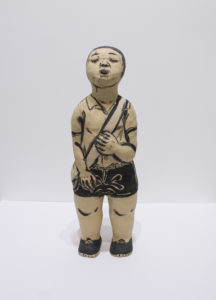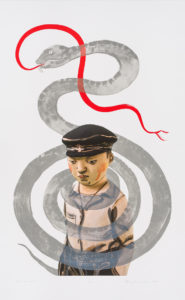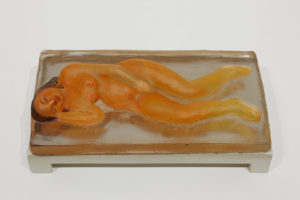December 10, 2020—February 27, 2021
James Harris Gallery is pleased to present an exhibition titled “In Search of Lost Time” focusing on three artists, Viola Frey, Fay Jones, and Akio Takamori. Inspired by the Proust novel, the pandemic and our last exhibition at our Pioneer Square address, this show draws connections with the nature of time, the transportive quality of memory, and the immense pleasure in the details of looking at objects. The exhibition demonstrates how artists engage with their personal histories to present a reflection of humanity in their work. Each artist chosen often draws on their lived experience for the basis of the objects they create. Proust’s novel “In Search of Lost time” emphasizes the link between reading and self-knowledge. He believed that with each reading of a book, a different meaning emerged. This can be said to be true when looking at art. Seeing things again often will lead to new interpretations. The exhibition is organized into three chapters, Akio Takamori’s drawings and sculpture will be on view in first room when you enter the gallery, Viola Frey’s works on paper and ceramic sculpture will be displayed in the middle space and Fay Jones in our back gallery.
Viola Frey
Many people think of Viola Frey as a maker of ceramic objects. Formerly trained as a painter, she studied with both Richard Diebenkorn and Mark Rothko, Frey’s practice incorporated painting, drawing and even photography. Frey was a cultural observer and her work reflected how she interpreted the world. One core theme explored throughout her career was the social commentary on the power structure between male and female and the roles they played during her lifetime. This investigation is prescient today with the continued struggle for equal rights and the upward path to break the glass ceiling. Her work was strongly influenced by her passion for art history, and her resulting imagery can often be viewed through this lens.
Fay Jones
Fay Jones’ work conveys the intimacy of mind, emotion, and spirituality. As a whole, Jones’ paintings echo a tremendous sense of humanity. The pieces meld figures, animals and symbols to conjure up existential meaning of human experience. Her characters become signifiers, representing the watery depth of the unconscious.
Fay Jones received a BFA from the Rhode Island School of Design in 1957. Awards she has received include the Joan Mitchell Painters and Sculptors grant in 2013, the Seattle Art Museum’s 2006 Poncho Artist of the Year award, grants from the NEA in 1983 and 1990, the Washington State Arts Commission in 1984, and La Napoli Art Foundation in 1989. Her work has been extensively collected in the Northwest, and is included in the collections of the Portland Art Museum and the Hallie Ford Museum of Art in Oregon, and the Seattle Art Museum and the Tacoma Art Museum in Washington, as well as the Cities of Seattle and Portland. Major exhibitions include a 2007 retrospective at the Hallie Ford Museum of Art at Willamette University, a 1997 traveling retrospective with the Boise Art Museum, and exhibitions at the Portland Art Museum, the Seattle Art Museum, the Museum of Northwest Art in La Conner, WA, the Anchorage Museum of History and Art, and the Palm Springs Desert Museum in California.
Akio Takamori
Takamori was a seminal figure in ceramic art, whose work over the past thirty years has left an enduring impact on the Pacific Northwest arts and the medium itself. His work is often autobiographical, drawing on his life in Japan, his family, and mythological themes. He is known for his coil-built figurative sculptures in which the narrative painting defines the form. Takamori explored themes of cultural identity by engaging the history of Eastern and Western aesthetics. Bold form and color defines his body of work, which is highly expressive of human emotion and sensuality.
Akio Takamori was born and raised in Japan. He has been exhibiting in the United States, Europe and Asia since the mid 1980s. Takamori received his BFA from the Kansas City Art Institute in 1976 and his MFA from the New York State College of Ceramics, Alfred University in 1978.
Takamori’s work is included in numerous collections including the Nelson-Atkins Museum of Art in Kansas City, Los Angels County Museum of Art, Victoria & Albert Museum in London, Ariana Museum in Geneva, the Seattle Art Museum, and the Museum of Arts and Design in New York City. He is the recipient of numerous awards, including three National Endowment for the Arts Visual Artists Fellowship Grants (1986, 1988, 1992), the Joan Mitchell Foundation Painters and Sculptors Grant (2006), and the USA Ford Fellowship (2011). Takamori was a professor of art at the University of Washington. He lived and worked in Seattle.
gouache on paper
11" x 15"
Art © Artists’ Legacy Foundation/Licensed by ARS, New York
Ceramic and glazes
8 1/2" x 7 1/2" x 6"
Art © Artists’ Legacy Foundation/Licensed by ARS, New York
ceramic and glazes
25" x 15 1/2" x 14 3/4"
Art © Artists’ Legacy Foundation/Licensed by ARS, New York
pastel on paper
42" x 30"
Art © Artists’ Legacy Foundation/Licensed by ARS, New York
Ceramic, glazes, and copper luster
23" x 16" 15"
Art © Artists’ Legacy Foundation/Licensed by ARS, New York
Acrylic on Okawara Paper
38" x 41 1/2"
Private Collection
Acrylic paint over etching
21" x 26 1/2"
Watercolor on paper
Image: 7 ¼” x 5 ¼”
Frame: 16 ¼” x 13 ¾”
Watercolor on paper
Image: 7 ¼” x 5 ¼”
Frame: 16 ¼” x 13 ¾”
Watercolor on paper
Image: 7 ¼” x 5 ¼”
Frame: 16 ¼” x 13 ¾”
Watercolor on paper
Image: 7 ¼” x 5 ¼”
Frame: 16 ¼” x 13 ¾”
Acrylic and collage on paper
42 ¾” x 76 ½”
Private Collection, San Francisco, CA
Acrylic on Okawara paper
25 1/2" x 56 1/4" unframed
Private Collection, Boulder, CO
Acrylic on wood panel
20" x 24"
Private Collection, Bellingham, WA
Stoneware with underglazes
28 1/2" x 19" x 6"
Inquire about this work
Stoneware with underglazes
43 1/2" x 15" x 9"
Inquire about this work
Ink on paper
50” x 48” unframed 52 ½” x 40 ½” framed
Inquire about this work
Stoneware with underglazes
25 1/2" x 8" x 7 1/2"
Archival ink jet and hand lithography on Somerset, Enhanced
Paper Size: 41 1/2" x 26" Image size 34 3/4" x 21 3/4"
Edition of 35
Inquire about this work
Sand cast glass with oil paint, concrete
4" x 14" x 7"

